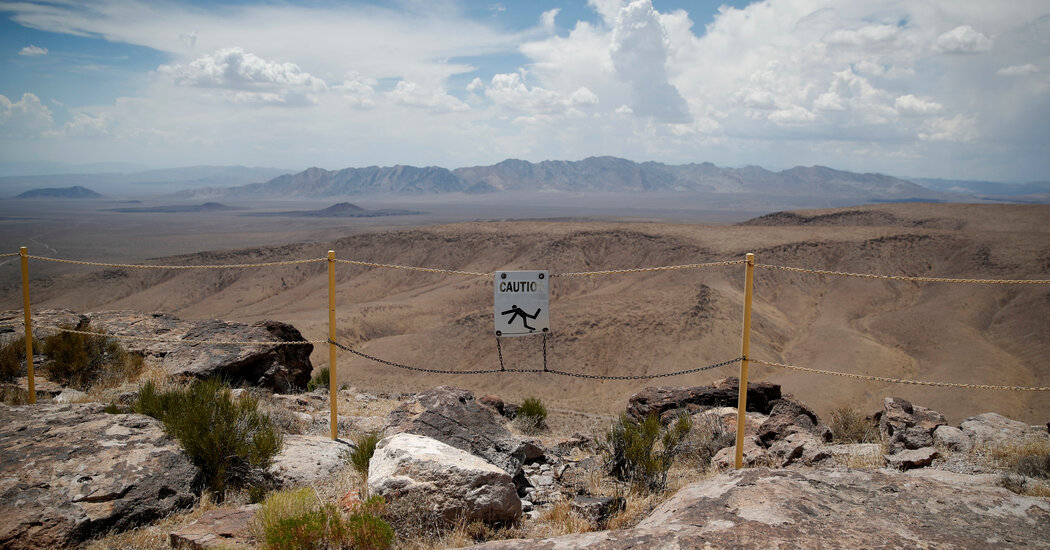[ad_1]
A significant shift in donor contributions to nonprofits fighting climate change in recent years has left some of the nation’s biggest environmental organizations facing critical shortfalls in programs on toxic chemicals, radioactive contamination and wildlife protection.
The Natural Resources Defense Council is shutting down its nuclear mission and has laid off its top lawyer in the field, Geoffrey Fettus, who led decades of litigation against the Energy Department to force radioactive waste cleanup and halt the creation of a nuclear waste dump at Yucca Mountain in Nevada.
The NRDC is not alone. The Sierra Club, Defenders of Wildlife and the Environmental Working Group, which have been at the forefront of efforts to clean up waste water, regulate pesticides and adopt tougher standards for atomic power plants, are facing similar financial problems.
“Most environmental programs don’t have significant toxics programs anymore,” said Ken Cook, founder and president of the Environmental Working Group, which still devotes nearly half its budget to battling toxics in food, personal care items, cleaning products and water.
Meanwhile, global spending to fight climate change by environmental groups and other nonprofits reached $8 billion in 2021, most of it in the United States and Canada, according to a survey released in September by the Indiana University Lilly Family School of Philanthropy.
Money has flowed into such groups as the ClimateWorks Foundation, which had revenues of $366 million in 2021. In its own report last week, ClimateWorks said that international funding from foundations for climate work had more than tripled since 2015, though it hit a plateau last year.
“Funders that had a nuclear program or a toxics program have left those fields entirely and have gone to climate change,” said Marylia Kelley, senior adviser and former executive director of a citizens oversight group that has long challenged the Lawrence Livermore National Laboratory in California on releases of radioactivity and national security issues.
Leaders of some legacy environmental groups largely agree that climate change, given its wide range of increasing global effects, is a top priority. But they warn that toxics in communities across the nation remain an immediate threat to human health and animal habitats. There is also concern about the growing acceptance of nuclear energy as a “clean” source of electricity.
Mr. Fettus, who declined to discuss his recent layoff, was regarded as a singular force in the fight to clean up nuclear waste sites in Washington, New Mexico and South Carolina, among other places.
“If there is no replacement, it will be a field day for the Department of Energy,” said Tom Carpenter, former executive director of Hanford Challenge, which monitors the highly contaminated Hanford weapons site in Washington State.
The NRDC has spent decades filing lawsuits against the department to force it to do more comprehensive cleanups at Hanford and other nuclear sites, and push it to do the work more quickly. The federal government is seeking to renegotiate and possibly scale back some of the prior legal agreements reached, just as the NRDC steps off the field.
The environmental organization, which over the years has also filed lawsuits against other government agencies over issues such as water quality, wildlife protection and climate change, cut nearly 40 positions from its staff of 740.
It also eliminated its work on California water resources and antibiotics in agriculture, a spokesman said.
Similar financial woes hit Defenders of Wildlife this year, one of the nation’s largest organizations working to protect and restore threatened species in North America.
That organization, founded in 1947, eliminated 22 staff positions, according to Defenders United, a union representing employees. A spokeswoman for the organization declined to comment, but union officials said on their website that managers cited an unsustainable budget deficit when they announced 14 layoffs in a “brief, last minute meeting with staff.”
The funding shift to climate has been compounded by several other forces, including a $9 million drop in small-donor contributions, part of a decline in overall giving after the “Trump bump” when President Donald J. Trump was in office, said Phil Radford, chief strategic officer of the Sierra Club and the former head of Greenpeace.
Government stimulus payments during the coronavirus pandemic also had prompted some people to increase their charitable contributions, an effect that has dissipated over the past two years, several environmental groups said.
And there is an increasing tendency among younger donors, particularly those who ascend to control large family foundations, to consider climate change more urgent than other environmental threats, the groups said.
The Sierra Club warned last spring of a $40 million deficit if it did not cut costs. The club declined to disclose how many layoffs it conducted this year.
The “budget crisis” forced the club to consolidate programs and eliminate duplication, but it did not eliminate any of its missions, Mr. Radford said.
Meanwhile, the Sierra Club has increased its work on climate change since Hurricane Katrina in 2005, outpacing some of the club’s other work. For climate, “There’s increasing money out there,” Mr. Radford said.
Within the larger community that monitors public policy, there is growing concern that priorities have become lopsided.
“It is good that we have all consolidated around the crisis of climate change — but at what cost?” said Danielle Brian, executive director of the Project on Government Oversight, which has long monitored the country’s secretive nuclear weapons complex and the toxic pollution they produced.
“Toxics are a foundation of the movement for open government. It all started with communities wanting to know about toxics in their environment,” she said.
The shift in priorities is also reflected in government policy, with climate change winning the lion’s share of some agencies’ budget increases. The E.P.A.’s list of seven priorities in its five-year strategic plan begins with “tackle the climate crisis.”
The climate change issue has attracted support from a number of deep-pocketed billionaires, including Bill Gates, Michael Bloomberg and Jeff Bezos. There is also a growing clean energy industry, including solar, wind, battery and manufacturing ventures, all advocating progress on climate, said Kathryn Phillips, the Sierra Club’s former director in California.
By contrast, she said, many environmental groups have been left to fight solo against powerful chemical companies and government agencies to force stricter regulations on toxic exposure and better cleanups.
The NRDC’s president, Manish Bapna, said the organization was not withdrawing from its toxics work but “sharpening its portfolio,” with an eye toward investing in issues where it could demonstrate significant impact, including climate change.
Those issues include lead in local drinking water, tailpipe emissions in trucks and contamination from trichloroethylene and polyfluorinated substances that are now ubiquitous in humans and animals, Mr. Bapna said.
Erik Olson, a lawyer for the group who handles water and toxics, said fund-raising for toxic contamination issues was difficult even before the growing alarm over climate change. “There has always been a challenge to do water and toxics. It has never been a well-funded area,” he said.
In its nuclear work, the NRDC helped to fund and litigate many suits brought by local groups, such as Nuclear Watch New Mexico and Tri Valley CAREs in California, which monitor the Energy Department’s two nuclear-weapons design labs.
“Clearly, it is a huge loss to have NRDC leave the field,” said Jay Coghlan, executive director of Nuclear Watch New Mexico. “It was nearsighted. But youth is more interested in climate change. If you really want to see climate change, just wait to see what happens after a nuclear war.”
Ed Chen, the NRDC’s former federal communications director, said passage of the Inflation Reduction Act in 2022, which provided large subsidies for electric vehicles and green power, signaled that the federal government was dramatically increasing its commitment to fighting climate change. He sees the NRDC’s move as a “strategic pivot” to keep the organization in line with the shifting priorities.
The Biden administration has also proposed tight new regulations on emissions from vehicles and power plants. But some see the big boost in federal funding as a retreat from more direct regulatory systems for greenhouse gases.
“The Inflation Reduction Act is not the kind of environmental bill that we had in the past,” said Mr. Cook, of the Environmental Working Group. “It is just a big spending bill.”
The growing concern over climate change has touched off a slightly different debate in the environmental community: how to approach the issue of nuclear power.
There is increasing support among some environmental groups for commercial atomic power plants as an alternative to fossil fuels — which often comes with hefty donations from those concerned about climate change.
Edwin Lyman, director of nuclear power safety at the Union of Concerned Scientists, which has warned about the safety of nuclear power and the hazards of its waste, said environmental groups were “under an awful lot of pressure to adopt nuclear power without reservation.”
Mr. Gates, the Microsoft founder, is now the chairman and largest investor in the nuclear power company TerraPower, which was founded to create what the company calls “safe, affordable and abundant carbon-free energy.”
TerraPower’s first 345-megawatt reactor — using uranium fuel enriched to a level about four times as high as traditional commercial reactors — is under construction in Wyoming at a cost of about $4 billion, said Jeff Navin, director of external affairs for the company and a former Energy Department chief of staff.
In the environmental community, Mr. Lyman said, Mr. Gates’s entry into the debate “was a game changer.”
And while Mr. Lyman’s organization is not explicitly against nuclear power, he says it is not essential to fighting climate change. “It’s more complicated,” he said.
[ad_2]
Source link




